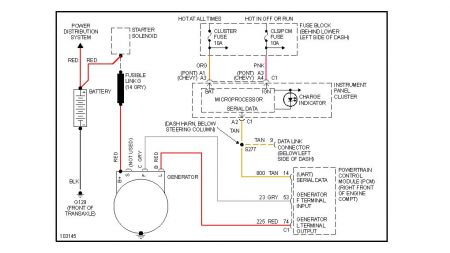A fuse link wire is a regular wire but of one gauge smaller than the wires it protects, so it's the weak link in the chain. The insulation is designed to not burn or melt. The advantages are they aren't susceptible to loose or corroded terminals like regular fuses are, and they will withstand a temporary overload from a motor that's starting up without nuisance blowing. The disadvantages are they're relatively difficult to replace and they're often in places that are hard to get to. They're often buried because they typically never need to be replaced for the life of the vehicle.
Chrysler commonly put theirs all together in a bundle that runs around the left strut tower. Other manufacturers usually place individual fuse links in the wire they protect, so they can be found anywhere on the vehicle. GM liked to connect them to the large terminal on the starter solenoid. That was done for convenience since that was connected right to the battery positive post. The disadvantage to this is they sometimes get forgotten when replacing the starter.
The ways to identify a fuse link are by their dull color compared to regular wires which are shiny, and by the splice. The typical fuse link wire is four to eight inches long, and at the end is a terminal, heat-shrink tubing, or a plastic block. When you buy a replacement, you get about 12" of wire. That can be cut to make two or three repairs. The length when installed is not important. Just as with regular fuses, fuse links are color-coded to denote their current rating. The common colors are orange, gray, white, black, and green.
You can repair a fuse link by splicing the burned ends and sealing the splice with heat-shrink tubing, but at least a part of the finished repair has to keep a single wire intact. If the wire is doubled up for its entire length, that will have double the intended current rating and won't protect the wiring. The recommended repair involves cutting off all splices, then soldering the new fuse link wire to the ends of the regular wires. Always solder the splices and seal them with heat-shrink tubing. Never use electrical tape as that will unravel into a gooey mess on a hot day.
When you look at your starter solenoid, you'll see the battery cable bolted to the larger terminal, and there will be at least one much smaller wire bolted to that same terminal. That is often the fuse link wire starting right there. To test it, tug on it as I mentioned before. If it's burned open, the insulation will stretch very easily.
You can use a clip lead as a temporary jumper to verify everything else is working. The generator will never produce its maximum current except when the system is being load-tested, so the jumper doesn't have to handle much more than 40 - 50 amps if the battery is run down and is recharging. With the fuse link burned open, if the charging system is otherwise working, you'll find abnormally high voltage on the generator's output terminal unless the voltage regulator has things well under control. Fifteen to 18 volts is often found at that terminal while battery voltage stays at 12.6 volts or less.
Saturday, May 23rd, 2020 AT 11:47 AM
(Merged)

